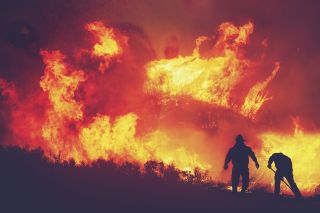Health
How Wildfire Smoke Alters the Brain
The effects of biomass smoke inhalation on mental health.
Updated September 3, 2023 Reviewed by Monica Vilhauer
Key points
- Evidence suggests that wildfire smoke exposure can indeed have detrimental effects on brain health.
- Wildfire smoke can induce inflammation in the brain that persists for more than a month.
- The hippocampus is particularly affected, risking long-term damage to learning and memory.
- Intermittent exposure to smoke poses a more serious risk due to surges in inflammatory activity.

Wildfire smoke is a complex mixture of gases and fine particulate matter (PM2.5) produced during the combustion of vegetation and other organic materials in a wildfire. While the immediate health risks of wildfire smoke are well-documented and include respiratory problems and cardiovascular issues, emerging research suggests that wildfire smoke exposure can also have significant effects on brain health and trigger inflammation in the central nervous system. Here’s an overview of recent research which demonstrates how this happens.
Wildfires
According to Natural Resources Canada, as of July 19, 2023, the interagency fire center has recorded 4,241 wildfires since the beginning of the year. The fires have scorched at least 11 million hectares — or over 27.1 million acres — of land across Canada. In the U.S., 74 large wildfires have burned 487,140 acres in 13 states. To date, 39,851 wildfires have burned 2,078,998 acres.
The number of wildland fire acres burned per year has roughly doubled since 1985. These fires now routinely generate smoke that deteriorates air quality for most of the country. This smoke contains a multifarious mixture of toxic components due to myriad combustion fuel sources (e.g., trees, grass, animals, homes, cars etc.). These tiny particles, known as PM2.5, are small enough to be inhaled deep into the lungs, where they can then enter the bloodstream and travel to the brain.
PM2.5 particles contain chemicals that can generate oxidative stress in the body. Oxidative stress occurs when there is an imbalance between harmful free radicals and the body's ability to counteract them with antioxidants. This oxidative stress can damage cells, including those in the brain.
The body's response to the presence of PM2.5 and other harmful substances in wildfire smoke includes the release of pro-inflammatory molecules, such as cytokines. These molecules can contribute to inflammation throughout the body, including the brain.
Wildfire exposures have been linked to cardiovascular, pulmonary, ocular, nasal and recently neurological outcomes, particularly in older people and those with chronic respiratory conditions.
A study from Washington State in 2020 estimated that 7.1 million people were exposed to average daily particulate matter (PM2.5) concentrations ranging from 30 to 190 µg/m3 for 13 consecutive day.
If all that wasn't already alarming enough, a recently published paper in the Journal of Neuroinflammation by University of New Mexico Health Sciences researchers gives new cause for concern, showing that wildfire smoke can trigger inflammation in the brain that persists for many weeks. Inhaled particulate matter from wildfire smoke and other pollutants induces the formation of fragmented peptides that impair the functioning of the blood-brain barrier. The blood-brain barrier consists of a layer of tightly packed cells lining blood vessels in the brain that act as a protective filter that separates the bloodstream from the brain tissue. It helps regulate the passage of substances into the brain. Wildfire smoke exposure has been associated with the disruption of the blood-brain barrier, allowing harmful substances to enter the brain and more easily lead to neuroinflammation and further activation of astrocytes and microglia, the immune cells of the brain.
Worse, the inflammatory process affects the hippocampus – the brain region necessary for learning and memory, thus leading to persistent deficits in cognition and attention associated with a range of neurological conditions, alterations in neurodevelopment in early life, and mood disorders throughout life. The scientists of this study did not see a complete resolution of the effects of smoke inhalation after 28 days, they stated, and that was very scary.
The human body seems capable of adapting to chronic particulate exposure to an extent, said the paper’s senior author, Matthew Campen, Regents’ professor in the College of Pharmacy and co-director of the UNM Clinical & Translational Science Center. But periodic exposures pose a problem because they cause a surge in inflammatory activity, and ill effects appear more related to the fluctuations, rather than the baseline levels of pollutants. “Part of what makes this so unique and worrisome is the intermittent nature of it,” he said. “We have rural communities that are otherwise enjoying clean beautiful air, especially in the Rocky Mountain region, and then, all of a sudden, they have suffocating levels of pollutants and it’s gone a week later. It’s a real hit to a naïve system.”
If you’re a firefighter, or if you just resided in a community that has had some of these dramatic smoke exposures, you could be experiencing neurocognitive or mood disorders weeks or months after the event.
Summary
The body's response to the presence of PM2.5 and other harmful substances in wildfire smoke includes the release of pro-inflammatory molecules such as cytokines. These molecules can contribute to inflammation throughout the body, including the brain. Prolonged exposure to wildfire smoke has been linked to a variety of neurological effects, including cognitive impairment, mood disturbances, and an increased risk of neurodegenerative diseases like Alzheimer's and Parkinson's disease.
Reducing exposure to wildfire smoke through measures like staying indoors during periods of poor air quality, using air purifiers, and wearing N95 respirator masks can help mitigate some of these risks. Additionally, addressing the root causes of wildfires, such as climate change and land management practices, is crucial for preventing the widespread and severe wildfires that produce harmful smoke.
References
Adetona O, Reinhardt TE, Domitrovich J, Broyles G, Adetona AM, Kleinman MT, et al. Review of the health effects of wildland fire smoke on wildland firefighters and the public. Inhal Toxicol. 2016;28:95–139.
Cleland SE, Wyatt LH, Wei L, Paul N, Serre ML, West JJ, et al. Short-term exposure to wildfire smoke and PM2.5 and cognitive performance in a brain-training game: a longitudinal study of U.S. adults. Environ Health Perspect. 2022;130:67005
Liu Y, Austin E, Xiang J, Gould T, Larson T, Seto E. Health Impact Assessment of PM2.5 attributable mortality from the September 2020 Washington State Wildfire Smoke Episode. MedRxiv Prepr Serv Health Sci. 2020;2020.09.19.20197921
Reid CE, Brauer M, Johnston FH, Jerrett M, Balmes JR, Elliott CT. Critical review of health impacts of wildfire smoke exposure. Environ Health Perspect. 2016;124:1334–43.
Scieszka D, Hunter R, Begay J, Bitsui M, Lin Y, Galewsky J, et al. Neuroinflammatory and neurometabolomic consequences from inhaled wildfire smoke-derived particulate matter in the Western United States. Toxicol Sci Off J Soc Toxicol. 2022;186:149–62.
Scieszka, D., Jin, Y., Noor, S.,... & Campen, M. J. (2023). Biomass smoke inhalation promotes neuroinflammatory and metabolomic temporal changes in the hippocampus of female mice. Journal of Neuroinflammation, 20(1), 1-15.
Wildfires and Acres | National Interagency Fire Center [Internet]. https://www.nifc.gov/fire-information/statistics/wildfires. Accessed 13 Jan 2023.




